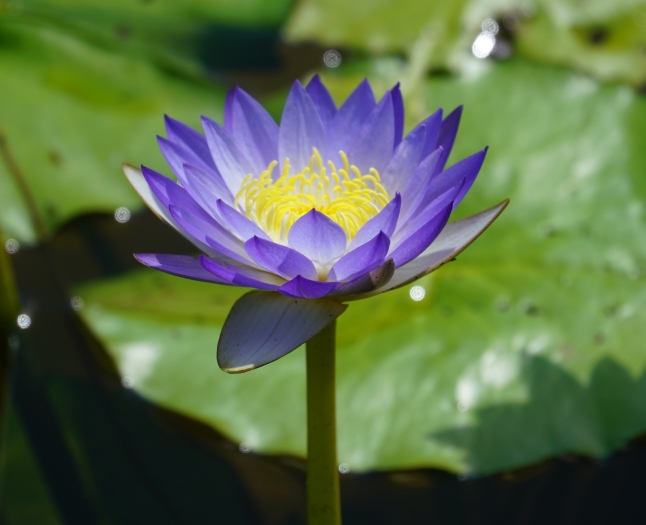Blue Lotus
(Nymphaea nouchali)
Blue Lotus (Nymphaea nouchali)
/
/

© Tim
CC BY 4.0
Image By:
© Tim
Recorded By:
Copyright:
CC BY 4.0
Copyright Notice:
Photo by: © Tim | License Type: CC BY 4.0 | License URL: http://creativecommons.org/licenses/by/4.0/ | Uploader: twan3253 | Publisher: iNaturalist |






















































Estimated Native Range
Summary
Nymphaea nouchali, commonly known as Blue Lotus, is a deciduous perennial aquatic herb native to still, freshwater habitats such as ponds, lakes, and slow-flowing rivers in South and Southeast Asia, Southern Africa, Australia, and the Pacific Islands. It typically grows to a height of 1 foot with a spread of 2-3 feet. The Blue Lotus is renowned for its striking flowers, which are usually violet-blue with reddish edges, though some cultivars may exhibit white, purple, mauve, or fuchsia blooms. The flowers, which are star-shaped when viewed from above, have four or five sepals and 13-15 angular petals, and they bloom during the day. The foliage includes both submerged and floating leaves, with the latter rising slightly above the water’s surface.
The Blue Lotus is celebrated for its showy flowers and is widely cultivated as an ornamental plant in water gardens and ponds. It is also integral to traditional and cultural festivals in Sri Lanka. In the aquarium trade, it is known as "dwarf lily" or "dwarf red lily," valued both for its flowers and underwater foliage, which some aquarists prefer to maintain by trimming the lily pads. For successful cultivation, the Blue Lotus requires full sun and should be planted in aquatic environments with standing water, mimicking its natural habitat. It is relatively easy to maintain, provided it is grown in the right conditions. Potential problems include water quality issues that can lead to poor growth or disease.CC BY-SA 4.0
The Blue Lotus is celebrated for its showy flowers and is widely cultivated as an ornamental plant in water gardens and ponds. It is also integral to traditional and cultural festivals in Sri Lanka. In the aquarium trade, it is known as "dwarf lily" or "dwarf red lily," valued both for its flowers and underwater foliage, which some aquarists prefer to maintain by trimming the lily pads. For successful cultivation, the Blue Lotus requires full sun and should be planted in aquatic environments with standing water, mimicking its natural habitat. It is relatively easy to maintain, provided it is grown in the right conditions. Potential problems include water quality issues that can lead to poor growth or disease.CC BY-SA 4.0
Plant Description
- Plant Type: Herb
- Height: 0.5-1 feet
- Width: 2-3 feet
- Growth Rate: Moderate
- Flower Color: Purple, Blue
- Flowering Season: Summer
- Leaf Retention: Deciduous
Growth Requirements
- Sun: Full Sun
- Water: Aquatic
- Drainage: Standing
Common Uses
Bee Garden, Bird Garden, Butterfly Garden, Fragrant, Showy Flowers, Water Garden
Natural Habitat
native to still, freshwater habitats such as ponds, lakes, and slow-flowing rivers in South and Southeast Asia, Southern Africa, Australia, and the Pacific Islands
Other Names
Common Names: Star Lotus, Red Water Lily, Dwarf Aquarium Lily, Blue Water Lily, Blue Star Water Lily, Manel Flower, Stern-Seerose, Stjärnlotus, Loto, Ninféia, Blue Lotos
Scientific Names: , Nymphaea nouchali, Nymphaea caerulea, Nymphaea stellata, Nymphaea ampla, Nymphaea capensis var. zanzibariensis, Nymphaea muschleriana, Nymphaea scutifolia, Nymphaea cyanea, Castalia scutifolia
GBIF Accepted Name: Nymphaea nouchali Burm.fil.